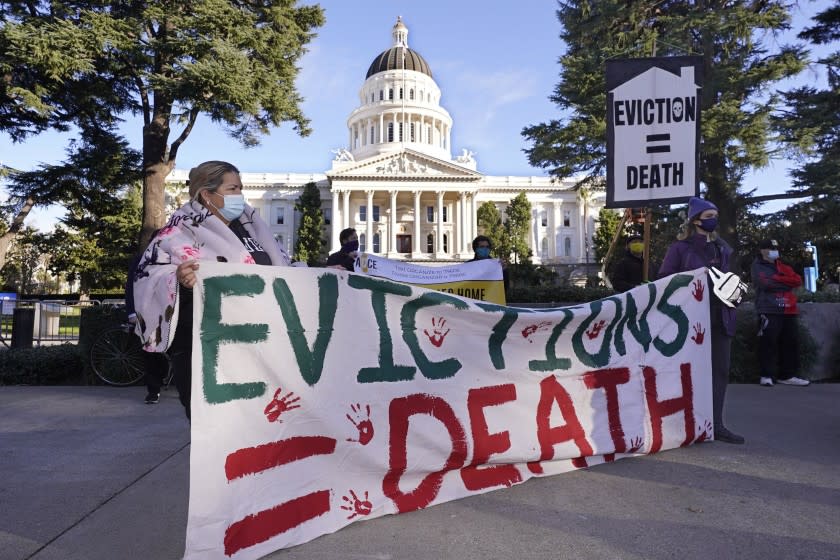Editorial: Now is not the time for California's landlords to resume evictions

- Oops!Something went wrong.Please try again later.
For the length of the pandemic, the fear of an eviction tsunami and crushing rent debt has loomed over struggling tenants. With California’s eviction moratorium set to expire in a little over a week, how Gov. Gavin Newsom and legislative leaders manage the end of pandemic tenant protections and the distribution of federal rent relief will be a test of their commitment to an equitable recovery.
Done well, California could create a strong safety net that ensures vulnerable tenants are protected from losing their homes or suffering lasting financial harm. Done poorly, the state could exacerbate existing disparities and worsen the crisis of homelessness and housing instability. The choice should be clear: California should leave no tenant behind.
The good news is that lawmakers are very likely to extend the eviction moratorium to allow more time for tenants and landlords to receive federal funding that will clear rent debt and avoid the threat of eviction. That makes sense.
Like many states, California has been abysmally slow in doling out the billions of dollars Congress allocated to help tenants cover unpaid rent. Just over 2% of people who have applied for rent relief have received the money, according a recent report. It would be a travesty if California allowed evictions to resume while sitting on pandemic rental assistance funds. Given the tremendous upheaval and the long-term repercussions of an eviction for tenants, it’s only fair to extend the moratorium a bit longer so the state can get the money to landlords.
But the eviction moratorium is just one piece of the puzzle. Several changes are needed to the state’s existing rent relief program to ensure that vulnerable tenants aren’t excluded from receiving much-needed aid.
The state divvied up the first round of federal relief dollars by population rather than need. That will benefit some communities and leave others behind. For example, in cities with more homeowners, higher incomes or low rents, the federal money could be enough to pay all rent and utility debt for qualified tenants and provide rental assistance for several months into the future.
But in high-need areas, like Los Angeles, with high rents and a large population of low-income tenants, the money will not stretch as far. In fact, projections show that under the current funding formula, L.A. will run out of rent relief early, leaving no financial assistance for 43% of renter households who have filed applications.
Newsom and legislative leaders have to fix the funding formula. It’s unfair and cruel to leave some tenants in debt or facing eviction simply because they live in a community that has more needs than funding. And we know who will be hurt the most by the shortfall: the groups that have been hardest hit by the pandemic economic fallout, including low-wage workers and single parents in Black, Latino and Indigenous households. If California leaders are serious about closing the state’s equity gap, then they have to ensure that communities with the greatest need get the rent relief they need.
There’s another problem: The financial assistance doesn’t cover the other kinds of debt that low-income tenants racked up during the pandemic so that they could keep paying their rent. Many paid their rent with credit cards, personal borrowing or payday loans. They don’t currently qualify for help but they still have crushing obligations that could damage their credit, making it harder to find a home or get a job in the future. These folks shouldn’t be penalized or cut out of the relief program.
Lastly, landlords cannot be allowed to decline rent relief. Under the current rules, property owners can refuse to accept the subsidy. That’s because the program would cover 80% of the debt and landlords would have to forgive the remaining 20%. Tenants could apply for assistance if their landlords rejected the subsidy, but they would only get 25% of their rent debt, which is enough to ensure they wouldn’t be evicted when the moratorium ends. They would still owe the rest of the money.
Newsom last month proposed covering 100% of rent debt for qualified tenants, using federal relief approved in March. He also said he wants to allow tenants to apply for the full amount themselves without relying on landlord cooperation. That should help. Still, tenant advocates worry that without explicit language in the law mandating acceptance by landlords, some property owners will refuse full reimbursement so they can get rid of particular tenants.
The federal government has given California an unprecedented $5 billion to help prevent a pandemic housing catastrophe. State leaders cannot allow renters to slip through the cracks.
This story originally appeared in Los Angeles Times.

